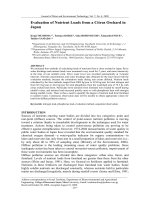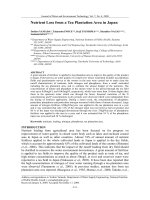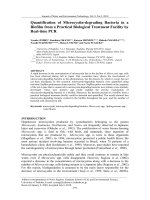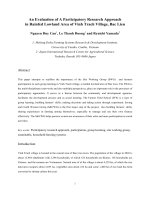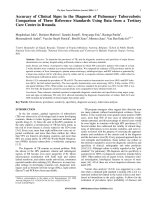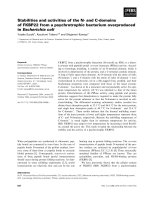Nutrient Loss from a Tea Plantation Area in Japan
Bạn đang xem bản rút gọn của tài liệu. Xem và tải ngay bản đầy đủ của tài liệu tại đây (337.85 KB, 10 trang )
Journal of Water and Environment Technology, Vol. 7, No. 4, 2009
- 331 -
Nutrient Loss from a Tea Plantation Area in Japan
Toshiro YAMADA*, Takanobu INOUE**, Koji TSUSHIMA***, Masahiro NAGAI****,
Yoshiaki KISO*****
* Department of Water Supply Engineering, National Institute of Public Health, Saitama
351-0197, JAPAN
**
Department of Architecture and Civil Engineering, Toyohashi University of Technology, Aichi
441-8580, JAPAN
***Department of Bioenvironmental and Agricultural Engineering, College of Bioresource
Science, Nihon University, Kanagawa 252-8510 JAPAN
****
Division of Human Environment, University of Human Environment, Aichi 444-3505,
JAPAN
*****
Department of Ecological Engineering, Toyohashi University of Technology, Aichi
441-8580, JAPAN
ABSTRACT
A great amount of fertilizer is applied to tea plantation area to improve the quality of the product
in Japan. Field surveys on water quality of a small river whose watershed includes tea plantation
fields and questionnaire survey to the owners in the area were carried out to make clear the
runoff characteristics of nutrients, both nitrogen and phosphorus, from a small watershed
including the tea plantation area, and to estimate the annual budget of the nutrients. The
concentrations of nitrate and phosphate in the stream water in dry period through the tea field
were up to 8.09mgN/L and 0.065mgP/L respectively, which were more than 10 times higher than
those in the upstream water which run through the forest. Seasonal variations of the N
concentrations and P concentrations in dry periods were observed which were independent from
the timing of fertilizer application. During a storm event, the concentrations of phosphate,
particulate phosphorus and particulate nitrogen increased while those of nitrate decreased. Large
amount of nitrogen fertilizer, 620kgN/ha/year, was applied to the tea plantation area in a year
and it was estimated that only 12% of the nitrogen input was recovered as harvest product and
86 % of the input was discharged downstream through the river. 55kgP/ha/year of phosphorus
fertilizer was applied to the area in a year, and it was estimated that 10 % of the phosphorus
input was recovered and 38 % discharged.
Keywords: nutrients, loading, nitrogen, phosphorus, tea plantation area.
INTRODUCTION
Nutrient loading from agricultural area has been focused on for progress on
improvement of water quality in closed water body such as lakes and enclosed coastal
seas in Japan as well as other countries. Almost 74% of annual amount of nutrient
fertilizer applied to the whole cultivated lands in Japan is applied to the dry fields,
which is account for approximately 63% of the cultivated lands of the country (Shiratani
et al., 2004). This indicates that the impact of the runoff loading from dry field should
be clarified to conserve the water environment downstream. A great amount of fertilizer
is applied to tea fields to improve the quality of the product such as taste of tea, and
high nitrate concentrations as much as about 50mg/L in river and reservoir water were
reported in a tea field in Japan (Nakasone et al., 2003). It have been also reported that
the high concentrations of nitrogen of river water running through a tea plantation area
were observed (Yamamoto et al., 2005). In previous studies, nutrient loss from tea
plantation area was reported (Hasegawa et al., 1985, Matsuo et al., 2000, Takeda et al.,
Address correspondence to Toshiro Yamada, Department of Water Supply Engineering, National Institute
of Public Health, Email:
Received January 6, 2009, Accepted November 17, 2009.
Journal of Water and Environment Technology, Vol. 7, No. 4, 2009
- 332 -
2002), although no evaluation in the storm periods was included in these studies. Impact
of nutrient loss during storm event should be taken into account to evaluate its annual
loading from non-point sources including tea plantation area. The objectives of this
study are to make clear the impact of the fertilizer application in a small watershed
including the tea plantation area on the river water quality and to estimate annual
balance of nutrients, nitrogen and phosphorus, in the area using the data including
survey results in a storm event.
MATERIALS AND METHODS
Study Site
Site of this study is located in central Japan. Annual mean air temperature and annual
precipitation at the observing station near the study site were 17.2 degrees C and 1797
mm, respectively, reported by the Japan meteorological Agency in 2004. The study site
is famous for the production of high-quality green tea leaves. The tea plantation in this
area started more than 60 years ago. The total area of watershed at the sampling point is
41.5ha, including the area of 4.5ha of tea fields. The major bedrock at the area is granite.
The watershed of the upstream is forest and no wastewater drainage is linked to the river.
Vegetative stage of tea trees is normally between March and October in this area.
According to a guideline for farmers on annual plan of tea plantation in this area,
application of basal fertilizer for tea growth in spring is normally conducted in the
periods between middle February and the end of March. Additional fertilizer in summer
and fertilizer for autumn growth are applied in early June and in the period between
August and September, respectively. Application of organic fertilizer such as rapeseed
meal is basically recommended, and annual nutrient application amounts of fertilizer are
66 kgN/ha as nitrogen and 25 kgP/ha as phosphorus in this area.
Fig.1 Map of the study site
Bedrock : granite
Sampling point
B (upstream)
Sampling point
A (downstream)
0 100 m
Forest (35.9 ha)
Tea (4.5 ha)
Fruit trees (0.3 ha)
Flow direction
Flow
Paddy (0.4 ha)
Fallow (0.4 ha)
Watershed
boundary
Ponds
Bedrock : granite
Sampling point
B (upstream)
Sampling point
A (downstream)
0 100 m0 100 m
Forest (35.9 ha)
Tea (4.5 ha)
Fruit trees (0.3 ha)
Flow direction
Flow
Paddy (0.4 ha)
Fallow (0.4 ha)
Watershed
boundary
Ponds
Journal of Water and Environment Technology, Vol. 7, No. 4, 2009
- 333 -
Sampling and analysis
The surveys were carried out monthly from April to December in 2003 as a preliminary
survey, and weekly from April to October in 2005. Water samples were collected from a
small river which flows through a tea field at sampling point A (Fig. 1). A survey during
a heavy storm event was also carried out in October 2004. In the period, water samples
were collected every 30 minutes. Samples of upstream at sampling point B were also
collected for the analysis of nutrient concentrations as for the background. The flow rate
at sampling point A was measured with an electromagnetic current meter at field
investigation. Water levels and precipitation were observed automatically at 10 minute
interval using an on-site monitoring system at the sampling point downstream in 2004
and 2005. Continuous at 10-min intervals water discharge data at the downstream site
were calculated using the relationship between the measured discharges with the current
meter and the automatically measured water levels. Electric conductivity (EC) and pH
were measured on site. Water samples transported to the laboratory were filtered
through a pre-combusted Whatman GF/F glass-fibre filter (mean pore size: 0.7 µm) for
the other analyses including concentrations of dissolved nitrogen (DN), dissolved
phosphorus (DP), nitrate, nitrite, ammonium, phosphate and other major ions. Those
analyses were performed in accordance with the official standard methods. Total
nitrogen (TN) and total phosphorus (TP) were analyzed with unfiltered water samples.
Concentrations of particulate nitrogen (PN) and particulate phosphorus (PP) were
calculated with the difference between TN and DN and those between TP and DP,
respectively.
Questionnaire surveys
Questionnaire surveys to the farmers in the tea plantation area were made in 2004 and
2005 to investigate the amount of fertilizer application in 2003 and 2005, respectively,
to know the annual fertilizer amount as nutrients input. Type, amount and application
timing of fertilizer that used through the year as well as nutrient contents of the
fertilizers were asked by the questionnaire survey to all owners. Monthly nutrient inputs
were calculated by the monthly amount of fertilizers and their content rates of nutrients.
RESULTS AND DISCUSSION
Water quality and seasonal variation of the nutrient concentrations
The mean values of the concentrations of major ions and those of nutrients in the
observation period, between April and December in 2003 and between April and
October in 2005, are shown in Table 1. Higher alkalinity and higher concentrations of
sulfate ion, potassium ion, magnesium ion and calcium ion at sampling point A than
those at B show that the tea plantation affects much the river water quality. The mean
concentrations of nitrate and phosphate in the stream water through the tea field were
8.09mgN/L and 0.065mgP/L respectively, which were more than 10 times higher than
those in the upstream water which run through the forest.
Journal of Water and Environment Technology, Vol. 7, No. 4, 2009
- 334 -
Fig. 2 shows the monthly specific amount of application of nitrogen fertilizer calculated
by the results of the questionnaire survey and the temporal variations of the
concentarations of TN in the river water. Total application amounts of nitrogen and
phosphorus in this area (4.5ha) in 2003 were 2830kgN and 250kgP, respectively. In this
tea plantation area, fertilizer was mainly applied in two seasons, which are early spring
during February and March for basal fertilization and summer during August and
September for additional fertilization. In the early spring of 2003, 46% and 47% of
annual amount of nitrogen and phosphorus were applied, respectively, while 37% and
38% were put in the summer. This pattern of the fertilizer application in the year is
typical in this region. As shown in Fig. 2, trend that the TN concentrations increase in
May and June and decrease in September to November was observed while almost of
all nitroigen fertilizer was applied intensively in February and March and August and
September. Fig. 3 shows the monthly specific amount of phosphorus fertilizer and the
variations of the concentrations of TP. The trend of TP concentrations in the river was
also different from those of the application. It is suggested that water quality in the tea
plantation area may not affect directly and immediately by fertilizer application.
However, it could also be suggested that nutrient concentrations increase in 3 or 4
months after fertilizer application.
Table 1 – Mean concentrations and coefficients of variance at the sampling point
and the upstream in the period between April and December in 2003, and
in the period between April and October in 2005.
Mean
CV* n**
Mean
CV* n**
Mean
CV* n**
Mean
CV * n**
pH 6.9
0.05 32
6.1
0.03 18
TN
(mg/l)
8.09
0.28 40
0.78
0.76 19
E.C.
(mS/m)
17.6
0.11 23
5.5
0.11 25
DN
(mg/l)
7.83
0.27 40
0.72
0.80 26
SS
(mg/l)
4.1
1.3 40
1.4
1.4 25
PN
(mg/l)
0.28
1.5 40
0.07
2.1 19
Alk.
(meq/l)
0.24
0.25 23
0.08
0.41 18
NO
3
-N
(mg/l)
7.47
0.26 40
0.76
0.78 26
Cl
-
(mg/l)
9.7
0.08 40
10.1
0.07 26
NO
2
-N
(mg/l)
0.008
4.3 40 (N.D.) 26
SO
4
2-
(mg/l)
30.4
0.12 40
4.9
0.06 26
NH
4
-N
(mg/l)
0.010
2.4 40 (N.D.) 26
Na
+
(mg/l)
7.2
0.07 40
6.5
0.10 26
TP
(mg/l)
0.065
0.74 40
0.003
0.86 18
K
+
(mg/l)
5.9
0.22 40
0.8
0.27 26
DP
(mg/l)
0.040
1.2 40
0.003
0.80 26
Mg
2+
(mg/l)
5.9
0.17 40
1.7
0.17 26
PP
(mg/l)
0.026
0.95 40
0.000
1.7 18
Ca
2+
(mg/l)
13.2
0.19 40
1.4
0.27 26
PO
4
-P
(mg/l)
0.033
1.1 40
0.001
1.9 26
* coefficient of variance, ** number of sample
Sampling point A Sampling point B
Downs tream Ups tre am
Sampling point A
Downstream
Sampling point B
Upstream
Journal of Water and Environment Technology, Vol. 7, No. 4, 2009
- 335 -
Fig. 2 – Temporal variation of nitrogen specific input as fertilizer to the tea
plantation area (A) and TN, DN. SS concentrations in the river water at
the sampling point A, and TN at B (B) in 2003.
Fig. 3 – Temporal variation of phosphorus specific input to the tea plantation area
as fertilizer (C) and TP, DP and SS concentrations in the river water at the
sampling point A, and TP at B (D) in 2003.
0.00
0.04
0.08
0.12
Apr May Jun Jul Aug Sep Oct Nov Dec
2003
TP, DP (mgN/L)
0
2
4
6
8
10
SS (mgN/L)
TP at B (upstream) TP at A(downstream)
DP at A(downstream) SS at A(downstream)
(D)
P fertilizer application in 2003
0
50
100
150
200
Jan Feb Mar Apr May Jun Jul Aug Sep Oct Nov Dec
Specific P input (kgP/ha)
(C)
0
2
4
6
8
10
Apr May Jun Jul Aug Sep Oct Nov Dec
2003
TN, DN (mgN/L)
0
2
4
6
8
10
SS (mgN/L)
TN at B (upstream) TN at A(downstream)
DN at A(downstream) SS at A(downstream)
(B)
N fertilizer application in 2003
0
50
100
150
200
Jan Feb Mar Apr May Jun Jul Aug Sep Oct Nov Dec
Specific N input (kgN/ha)
(A)
